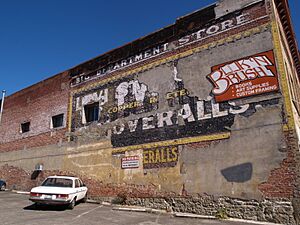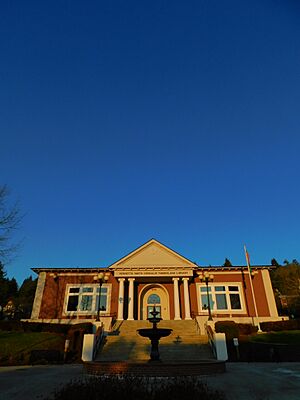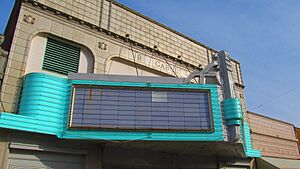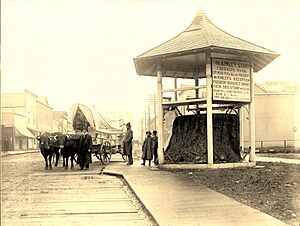Chehalis, Washington facts for kids
Quick facts for kids
Chehalis, Washington
|
|||
|---|---|---|---|
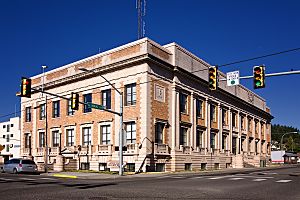 |
|||
|
|||
| Nickname(s):
the Rose City, the Mint City
|
|||
| Motto(s):
Where Heart and History Shape Our Future
|
|||
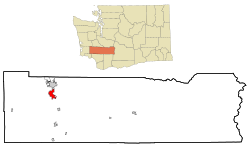
Location of Chehalis, Washington
|
|||
| Country | United States | ||
| State | Washington | ||
| County | Lewis | ||
| Area | |||
| • Total | 5.88 sq mi (15.23 km2) | ||
| • Land | 5.81 sq mi (15.04 km2) | ||
| • Water | 0.07 sq mi (0.19 km2) | ||
| Elevation | 243 ft (74 m) | ||
| Population
(2020)
|
|||
| • Total | 7,439 | ||
| • Density | 1,280.38/sq mi (488.44/km2) | ||
| Time zone | UTC-8 (Pacific (PST)) | ||
| • Summer (DST) | UTC-7 (PDT) | ||
| ZIP code |
98532
|
||
| Area code(s) | 360 | ||
| FIPS code | 53-11475 | ||
| GNIS feature ID | 1503929 | ||
Chehalis (say "shə-HAY-liss") is a city in Lewis County, Washington, United States. It is the "county seat," meaning it's where the main government offices for Lewis County are located. In 2020, about 7,439 people lived there.
The city is in the Chehalis valley, split by Interstate 5 (I-5) and State Route 6. It's like a "twin city" with Centralia, which is right next door. Other nearby towns include Napavine and Newaukum to the south, and Adna to the west. Because Chehalis is near the Chehalis River and other rivers like the Newaukum and Skookumchuck, it has had some big floods in the past.
Chehalis became an official city in 1883. It started as a place for logging and railroads. Later, in the mid-1900s, farming became more important. Today, the city focuses on making things and storing goods in large warehouses.
Chehalis is home to the old neighborhood of Claquato, the Chehalis–Centralia Airport, and the Southwest Washington Fairgrounds. The city has many historic spots, with 11 places listed on the National Register of Historic Places. This is more than any other area in Lewis County! You can also find museums about motorcycles, military history, and the city's railroad past. Chehalis has about 273 acres of parks, many of which were started with land given by local people and are cared for by volunteers. The city is also known for its fun summer event called ChehalisFest.
The Willapa Hills Trail starts in Chehalis, and many cyclists stop here during the Seattle to Portland Bicycle Classic. Chehalis even used to have a championship minor league baseball team and welcomed famous teams, including those from the Negro league baseball.
In recent years, Chehalis has started many projects to make the city better. These include fixing up the historic downtown, improving public transportation, and helping students in the school district graduate. They've also added art programs and improved the city's parks.
Contents
- What Does the Name Chehalis Mean?
- A Look Back: The History of Chehalis
- Where is Chehalis Located?
- Who Lives in Chehalis?
- How Chehalis Makes Money
- Arts and Culture in Chehalis
- Sports and Recreation
- Nature and Environment
- Learning in Chehalis
- Media in Chehalis
- City Services and Transportation
- Sister City Connections
- Famous People from Chehalis
- See also
What Does the Name Chehalis Mean?
The name "Chehalis" comes from the Chehalis people, a Native American group. They used a word that meant "place of sand" or "shifting sand" to describe a village near what is now Westport, Washington. Early explorers heard this word and started calling the native people "Chehalis."
The area was first known as Saunder's Bottom or Saundersville, named after Schuyler and Eliza Saunders, who settled there in 1850. In 1870, a founder of the town, Obadiah B. McFadden, changed the name to Chehalis. Another story says that officials for the Northern Pacific Railroad started using the name Chehalis in 1874. The state officially recognized the name in 1879. The name "Chehalis" likely refers to the Chehalis people and the Chehalis River. The original names, Saunder's Bottom and Chehalis, both fit the town well because of the muddy land along the Chehalis River. This muddy land made it hard for stagecoach travelers on the Oregon Trail between Kalama and New Market (now Tumwater).
A Look Back: The History of Chehalis
Chehalis started in 1873 as a small settlement around a warehouse next to a railroad track. This happened when the Northern Pacific Railroad built its line north from Kalama to Tacoma. The railroad bypassed Claquato, which was the county seat at the time, just three miles west. Because of this, the county seat moved to Chehalis, and Claquato became mostly a historical site.
By 1874, a store and several houses were built. The new town was first called Saundersville. In 1879, its name changed to Chehalis, after the Chehalis people. The name meant "shifting sands," describing the muddy land along the Chehalis River that caused problems for travelers on the Oregon Trail. Chehalis officially became a city on November 23, 1883.
Soon, Logging became a big business in the nearby forests. Workers from Scandinavia, England, and Scotland/Ireland came to settle in the valleys. By 1940, the main jobs in Chehalis included dairy farming, raising chickens, growing fruit, making condensed milk, packing fruits and vegetables, making bricks and tiles, coal mining, building portable houses, and shipping ferns.
Where is Chehalis Located?
According to the United States Census Bureau, Chehalis covers about 5.55 square miles (14.37 square kilometers). Most of this area is land, with a small amount of water.
The city is located right on Interstate 5, almost exactly halfway between Seattle, Washington, and Portland, Oregon. The historic downtown and most of the city's main areas are on the east side of the freeway, at the bottom of some forested hills. On the west side of the freeway, you'll find parks, farms, and some neighborhoods built in the hills. A small airport is just west of the freeway, toward the north end of the city. From the hills west of town, you can often see Mount Rainier, Mount Adams, and Mount St. Helens on clear days. Many bicyclists stop in Chehalis during the annual Seattle to Portland Bicycle Classic.
The Chehalis River flows through the valley where the city is, and the Newaukum River joins it there. Both rivers can flood when there's a lot of rain. The low areas from the freeway westward are especially likely to be covered in water during floods.
Chehalis Climate
Chehalis has warm, dry summers, but they are not too hot. The average monthly temperatures never go above 71.6°F (22°C). This type of weather is called a warm-summer Mediterranean climate.
Who Lives in Chehalis?
| Historical population | |||
|---|---|---|---|
| Census | Pop. | %± | |
| 1890 | 1,309 | — | |
| 1900 | 1,775 | 35.6% | |
| 1910 | 4,507 | 153.9% | |
| 1920 | 4,558 | 1.1% | |
| 1930 | 4,907 | 7.7% | |
| 1940 | 4,857 | −1.0% | |
| 1950 | 5,639 | 16.1% | |
| 1960 | 5,199 | −7.8% | |
| 1970 | 5,727 | 10.2% | |
| 1980 | 6,100 | 6.5% | |
| 1990 | 6,527 | 7.0% | |
| 2000 | 7,057 | 8.1% | |
| 2010 | 7,259 | 2.9% | |
| 2020 | 7,439 | 2.5% | |
| U.S. Decennial Census 2020 Census |
|||
In 2010, there were 7,259 people living in Chehalis. The city had 2,868 households and 1,655 families. About 87% of the people were White, 1.7% were African American, and 1.3% were Native American. About 11.6% of the population was Hispanic or Latino.
About 31.1% of households had children under 18. The average household had 2.36 people, and the average family had 3.02 people. The average age in the city was 33.5 years old.
How Chehalis Makes Money
After a big pharmaceutical factory closed in 1952, the people of Chehalis created a group called "Adventure in Cooperation." This group helped start the Chehalis Industrial Park later that decade. This economic area began when local volunteers, known as "Gandy Dancers," built a new rail line to the park. The industrial park, located south of the city near the interstate, rents out land to companies and businesses. The first business there was a large Goodyear Tire factory that opened in 1957.
The Port of Chehalis was officially created in September 1986. It was one of the last ports to be set up in Washington state. The port oversees the Chehalis Industrial Park and is part of the South Puget Sound Foreign Trade Zone.
Making and processing food, like canned or frozen items, has been an important part of Chehalis's economy for a long time. This became even more important in the 1950s after U.S. Route 12 and Interstate 5 were built.
Callison's, also known as I.P. Callison's & Sons, started in Chehalis in 1903. The company first processed cascara bark, which was used as a laxative. They also shipped different plants for flower arrangements. Callison's began producing peppermint in the 1940s and spearmint in 1952. Eventually, they started making essential oils, including oil from foxglove for medicine. While the company's main office moved to Lacey, the factory is still in Chehalis. They produce mint used in candies at Chehalis Mints, a local candy company that started in 1994.
The Lewis County Mall, located south of the Lewis County Fairgrounds, was built in 1972. It used to have big national stores, but many left after 1999 because other shopping centers grew in the area. In the 2000s, a 10-screen movie theater called Midway Cinema opened in the building. As of 2023, the mall has smaller, local businesses. There are plans to renovate the center for storage, apartments, and restaurants.
Timber, or wood, was once a very important part of the city's economy. It started to increase again in the 2000s. Chehalis became a center for warehousing because it's easy to get to the interstate and it's located between Portland and Seattle. In the 2010s, the city worked to have more types of businesses. They created an "auto row" for car dealerships in the Twin City Town Center. Also, because of improvements to the Recreation Park Complex and more people coming to sports events, the city's hospitality industry (hotels and restaurants) has grown.
Arts and Culture in Chehalis
Art Around Town
In 2009, the city council approved a plan to improve downtown Chehalis. The Chehalis Community Renaissance Team (CCRT) was formed to add art to the city. With money from donations and city, county, and state programs, local artists and business owners have decorated utility boxes, trash can lids, and benches. They've also painted murals and renovated building fronts in the downtown area.
A rainbow-painted fence, called the Chehalis Friendship Fence, is in the city's Pennsylvania-Westside district near Westside Park. It was first made in 2020 to show support for LGBTQ+ people and their rights.
You can find sculptures in Chehalis, like The Guardian, a bronze statue at the Lewis County Law and Justice Center. This artwork honors police officers who died while on duty. It shows a little girl with an officer and a police dog. Four statues of children playing are at the Recreation Park Complex. There's also a bronze sculpture of a little girl reading a book on a bench at the Vernetta Smith Timberland Library.
Chehalis is part of the ARTrails of Southwest Washington. This group, started in 2003, shows off local artists, art studios, and galleries in the region. They have an annual fall studio tour that includes events in smaller towns in Lewis County. The Lewis County Historical Museum has had a permanent ARTrails gallery since 2015.
Community Groups
One of the oldest women's groups in Washington state, the St. Helen's Club of Chehalis, was founded on February 5, 1895. This group, which focuses on literature, arts, science, and important issues, has been a member of the General Federation of Women's Clubs (GFWC) since 1896. The St. Helen's Club helps high school and college women with scholarships. In the early 1900s, they asked for clean streets, organized livestock drives, opened a women's rest stop downtown, and planted "a mile of trees" at the fairgrounds. They also helped restore the John R. Jackson House at the Jackson House State Park Heritage Site in 1915.
Food and Restaurants
In 2021, two restaurants in Chehalis, Once Upon A Thyme (a diner) and Mackinaw's (a fine dining restaurant), were featured on the TV show, Diners, Drive-Ins and Dives.
Chehalis also became home to the Sweet Dough Cookie Co. in 2024. This bakery, which used to be in Centralia, is owned by Ashlee Shirer, who won the Food Network's "Christmas Cookie Challenge" twice!
Fun Festivals and Events
The city hosts a yearly Community Farmers Market of Chehalis in its historic downtown from June to October. Started in 2005, it's part of a bigger farmers market effort in Lewis County. It's open on Tuesday afternoons and is the only market of its kind within 20 miles as of 2024. You can find local fruits, vegetables, prepared food, and art there.
An annual event called "ChehalisFest" usually happens at the end of July. It used to be called "Krazy Days" and included a "saucer drop" where candy and gifts were dropped from cardboard flying saucers. Experience Chehalis hosts the event, which takes place in the historic downtown and at local tourist spots like the Chehalis-Centralia Airport and Veterans Memorial Museum. The festival often features food, music, kids' activities, art walks, sidewalk sales, and car shows.
A free concert series called Music in the Park happens every mid-summer at Recreation Park. It's usually held on three Fridays in a row, with a different performer each night. Country singers and cover bands often perform.
Chehalis is next to the Southwest Washington Fairgrounds, which hosts an annual state fair in August. The Lewis County Fair first took place in Chehalis in 1891.
To remember the Kenneth Arnold UFO sighting and the city's connection to it, downtown Chehalis hosts the "Chehalis Flying Saucer Party." This festival started in 2019 and brought back the "saucer drop" tradition. It's usually a two-day celebration in September with talks, a parade, music, and UFO-themed activities. The Lewis County Historical Museum also has exhibits about the sighting. In 2023, a short film competition, the "Northwest Flying Saucer Film Fest," was added to the event.
Chehalis's Santa Parade happens in early December. Each year, a theme is chosen, and local residents are picked as grand marshals to honor their community service. The parade goes through the historic downtown with floats and school marching bands. This parade has been held almost every year since the 1940s and celebrated its 70th year in 2019.
Historic Buildings and Places
The city started a historical commission in the 1980s to recognize and preserve important buildings in Chehalis. This group, called the Chehalis Historic Preservation Commission, listed 37 homes in 2005. All of these homes were in historic districts in the community. Each home or building gets a plaque that shows when it was built and information about its preservation. The commission also helped start restoration efforts in the downtown area in the mid-2000s, especially programs to improve building façades.
The Chehalis Downtown Historic District was added to the National Register of Historic Places (NRHP) in 1997, especially for its Colonial Revival architecture. Two other NRHP districts in Chehalis are the Hillside Historic District and the Pennsylvania Avenue-West Side Historic District. Some NRHP-listed buildings include the Chehalis Post Office, the Lewis County Courthouse, the county museum (once the Burlington Northern Depot), the 1920s St. Helens Hotel, and the Troop 373 and 7373 Scout Lodge. The homes of John R. Jackson, O.B. McFadden, and O.K. Palmer are also on the NRHP list.
Other historic buildings include the Chehalis Theater, which opened in 1938 as the Pix Theater and was renamed in 1954. The building was first a Ford car dealership in 1923. Across from the courthouse is the Judge Seymour White House, a Victorian house built in 1904. It was almost torn down in 1986, but people protested and saved it. The 1889 Washington Hotel is in downtown. It was restored by a local family in 1997 after a fire. It used to be a movie house and vaudeville theater called the Dream Theater, and it once housed the Vintage Motorcycle Museum.
To celebrate 100 years since Ezra Meeker's journey on the Oregon Trail, the city placed a historical marker at city hall. Chehalis was one of the last towns on Meeker's trip to put up a marker. Another marker was later placed at Claquato Church in the nearby Claquato neighborhood. This is the oldest church in Washington state that has been used continuously.
The Vernetta Smith Chehalis Timberland Library was built in 2008. It replaced the city's original 1910 Carnegie library. The new library is run by the Timberland Regional Library and is named after the mother of former Chehalis resident, Orin Smith.
Places to Visit
Chehalis is home to the Veteran's Memorial Museum, which started in 1995 and opened in Centralia in 1997. The museum has a large collection of military history. Visitors can talk with United States war veterans and explore a 9,000-square-foot gallery. The museum also has the mast of the USS Nicholas (DD-449) and displays a complete Bell AH-1 Cobra helicopter and a Republic F-105 Thunderchief fighter-bomber. Since 2015, the museum has hosted an annual "Rust or Shine Car Show and Music Festival" in late summer, which is the biggest car show in the county. The museum also helps sponsor an annual American Civil War reenactment in the city.
The Chehalis-Centralia Railroad Museum (CCRM) is south of the veteran's museum. It runs the Chehalis–Centralia Railroad, which offers an 18.0-mile (29.0 km) passenger train ride through the Twin City area and the Chehalis River Valley. The train, a 1916 Baldwin Locomotive Engine No. 15, was once on display at Recreation Park and was fixed up in the mid-1980s.
A swap meet mall called Yard Birds is a local landmark known for its large, metal and wood sculpture of a black bird. The mall closed permanently in 2022, but the attraction still remains as of 2023.
At the Lewis County Historical Museum, you can see the McKinley Stump. This is a copy of a 6-foot (1.8 m) tall part of a Douglas fir tree cut down in 1901. The original stump was between 360 and 700 years old. It was meant to be a stage for President William McKinley to give a speech, but his visit was canceled. Theodore Roosevelt used it two years later, and William H. Taft used it as a podium in 1907. The original stump was damaged by fire in the late 1940s and later by carpenter ants. In 2007, it was removed from Recreation Park. A new copy, cut from a tree in Tenino, was put in the museum in 2008, along with a restored pagoda and a piece of the original stump.
Sports and Recreation
Bicycling is a popular sport in Chehalis. The city and other towns on the State Route 6 corridor host an annual "Ride The Willapa" bike ride that raises money for the Willapa Hills Trail. The Lewis County Historic Bike Ride, an annual event since the early 1990s, has different routes for all skill levels and goes through the city. This ride is used by Seattle to Portland Bicycle Classic (STP) participants as practice. Chehalis is part of the STP route, which goes around the airport and through downtown. STP riders can stay overnight in Chehalis if Centralia is full.
Chehalis's Millet Field used to host minor league baseball teams like the Gophers, Proteges, and Farmers. The 1912 Chehalis Farmer's team even won the league championship. The field was also used for semi-pro baseball and football from the early 1900s to the 1970s. Several Negro League games were played in the town.
Two parks in the city, Recreation and Stan Hedwall Parks, are used for sports competitions by W.F. West High School and for tournaments involving other high schools in Lewis County. In 1970, the high school hosted a preseason basketball game between the Portland Trail Blazers and the Seattle SuperSonics, which started the I-5 Rivalry.
Parks and Fun Places
Chehalis has several parks, many of which were built on land donated by local residents. Money to build, maintain, or improve the parks has often come from community fundraising.
The largest park is the Recreation Park Complex, located in Chehalis's South Market district. It has four separate areas. The Gail and Carolyn Shaw Aquatics Center opened in August 2014, replacing the original 1959 Chehalis Community Pool. The Chet and Henrietta Rhodes Spray Park, finished in 2007, is next to the aquatic center and is great for young children and people with disabilities. Recreation Park itself is the largest area, with four softball and youth baseball fields, picnic spots, paved walking paths, and a community center. It was rebuilt in 2020, along with the Penny Playground, a fenced play area for children. The playground's name comes from the donation drives that helped fund its building in 1993.
Two other parks are set up for sports. Stan Hedwall Park is on both sides of the Newaukum River and has 200 acres of ball fields, RV parking, trails, and open and forested areas. Millett Field used to be home to a semi-pro baseball team in the early 1900s and has been used for sports since it opened in 1898. This 3-acre (1.2 ha) park has a basketball court and a playground, both built by local charity efforts in the early 2000s.
Several parks for relaxing and family activities are located throughout the city. Westside Park, in the Pennsylvania Avenue-West Side Historic District, has basketball courts, a playground, and picnic areas. Lintott-Alexander Park, a 6-acre (2.4 ha) park, was restored in 2004 with money from a former resident. Two of the oldest recreational areas, John Dobson and McFadden Parks, are a combined 56 acres (23 ha) and are on Park Hill in the Hillside District. A shared trail, the Dobson-McFadden, connects these parks and offers great views of Chehalis and the Newaukum River valley.
While many Chehalis parks have walking paths, there are three special trails. The Airport Levee Trail is a mix of paved and gravel, looping for up to 3.5 miles (5.6 km) between farmland and the Chehalis-Centralia Airport. It connects to the Airport Road Trail, a paved trail that runs next to Interstate 5 for 2.0 miles (3.2 km). This is part of a plan to connect recreational areas between the Twin Cities. The Willapa Hills Trail stretches 56.0 miles (90.1 km) from Chehalis to South Bend, Washington. Built over an old railroad line, it's now a mix of paving and compact gravel and is open to hikers, bicyclists, and horse riders.
Nature and Environment
The city owns and runs the Chehalis Poplar Tree Farm, located east of Claquato on State Route 6. This 250-acre (100 ha) farm grows nine types of poplar trees. The trees are harvested in sections every 8 to 10 years, and the wood is sold to make paper. The farm is also part of Chehalis's water treatment program. Since 2008, treated wastewater is used to water the poplar fields instead of being fully released into the Chehalis River. Water not absorbed by the trees goes back into the local underground water supply. The farm used to be called the "Chehalis Poplar Tree Plantation," but its name was changed in 2021 because the word "plantation" was considered offensive.
The area has many cascara plants, which can be a bush or a tree. The bark of this plant is harvested and commonly used as a laxative.
The Chehalis River and Dillenbaugh Creek areas in the city are home to migrating coho salmon. You can also find beaver and deer in these ecosystems.
Learning in Chehalis
The Chehalis School District (CSD) provides public education for students from pre-kindergarten to 12th grade in the city.
The public schools are:
- James W. Lintott Elementary - For pre-kindergarten to 2nd grade.
- Orin C. Smith Elementary - For 3rd to 5th grade.
- Chehalis Middle School - Built in 1989, for 6th through 8th grades.
- W.F. West High School - Opened in 1951, for 9th to 12th grades.
Both elementary schools were built in 2018 and fully opened in 2019. They replaced older schools: Cascade (built 1922), R.E. Bennet (opened 1928), and Olympic (built 1960).
The city also has Green Hill School, which provides schooling for young males who are rehabilitating. Students there can earn a high school diploma or a GED (General Equivalency Diploma), get vocational training, and take college prep courses. They can even earn an associate or bachelor's degree through a partnership with Centralia College.
Media in Chehalis
Movies and TV
Several movies have been filmed in and around Chehalis, including Captain Fantastic and the independent film Maysville. Documentaries filmed in the city include Chehalis : A Watershed Moment, about the Chehalis river basin, and Skinny and Fatty: The Story of Yard Birds, about a local market.
Newspapers
The first newspaper in Chehalis was the Lewis County Nugget in 1883. The Lewis County Bee started a year later. Over time, these papers merged, and by 1963, The Chehalis Advocate was the only city-produced newspaper, but it also closed. Since then, Chehalis has not had its own newspaper. Local news for Chehalis residents is now provided by The Chronicle, a weekly newspaper published in Centralia.
In 2009, a "ghost sign" (an old painted advertisement) for the Chehalis Bee-Nugget newspaper was found and saved during renovations of Chehalis's historic St. Helens Theater.
Radio Stations
The Chehalis area has two licensed FM radio stations: KACS - 90.5 FM, which plays Christian music, and KMNT - 104.3 FM, which plays country music. Other stations include Centralia College's KCED - 91.3 FM, which plays Alternative music, and KITI-FM - 95.1 FM, an Adult contemporary music station from Winlock. The AM radio station KELA 1470 from Centralia broadcasts sports and talk shows.
City Services and Transportation
Flood Control Efforts
Lewis County and other local governments, along with environmental groups and citizens, started a partnership in the early 2010s called the Chehalis Basin Strategy. This group works on plans to reduce flooding along the Chehalis River and restore the natural home for local Chinook salmon. Their plans include improving levees (walls to prevent flooding) around the Centralia-Chehalis Airport and building a flood retention dam in Pe Ell. This dam is meant to limit damage from very large floods in the Chehalis River Basin.
Healthcare Services
The first hospital in Chehalis was built in 1903. In 1907, St. Helens Hospital was built to care for elderly and poor citizens. This hospital was expanded several times.
Chehalis is served by Centralia's 128-bed Providence Centralia Hospital. This hospital provides short-term care, surgery, cancer treatment, and has a 24-hour emergency room. There are also several clinics in Chehalis, including Providence Chehalis Family Medicine and Northwest Pediatric Care. Mental health services are provided by Cascade Mental Health Care.
The Lewis County Public Health & Social Services building is in the city's government district.
Getting Around Chehalis
Chehalis is served by Interstate 5, the main north-south freeway in Western Washington. This freeway connects the city to Seattle and Portland. U.S. Route 12, an east-west highway, also passes through Chehalis. It goes to Aberdeen and across the mountains to the Yakima River Valley and Tri-Cities. Chehalis is also where State Route 6 ends. This highway travels west to U.S. Route 101 in Raymond.
Four other bridges provide direct access to the city. Chamber of Commerce Way connects to the city shopping center. The West Side Bridge goes into the Pennsylvania Avenue-West Side Historic District and toward downtown. The 13th Street Bridge connects to the South Market district, Recreation Park, and Green Hill School. The Labree Road Bridge, built in 2007, provides a way to get to the Port of Chehalis.
Twin Transit provides public bus service to Chehalis and Centralia. In the early 1900s, people used a streetcar line run by the Twin City Railroad Company to travel between Chehalis and Centralia. This service stopped by 1929 as people started using buses more.
The Chehalis–Centralia Airport (CLS) is located within the city. It's a single-runway airport for public use in Lewis County. It started as a small airfield in 1927 and is about one mile west of downtown Chehalis. It's the largest of the three airports in the county.
Railroads in Chehalis
Chehalis first connected to new railroads in 1873 when a depot was built in Newaukum. A local resident paid a train conductor to stop in Saundersville, which led to a warehouse depot being built in what became Chehalis. A proper train station was finished in 1883. This was replaced in 1912 by a depot that is now the Lewis County Historical Society and Museum. The economy in Chehalis grew a lot because of the railroads.
Competing railroad companies tried to connect Chehalis to the Pacific coast around 1890. One company, the Pacific, Chehalis & Eastern, ran a line to Sea Haven, but it failed by 1891. A freight railroad that went to South Bend, run by the Northern Pacific Railway Company, became successful after it fully opened in 1893. Passenger train service on this line brought more shoppers to the city. However, passenger trains became less common during the Great Depression and stopped by 1954 because more people were traveling by car.
In 1916, Chehalis also had a short rail line run by the Cowlitz, Chehalis, & Cascade Railroad. This line transported milk from local dairy farms to factories in the city and brought lumber from nearby forests to sawmills in Chehalis.
Other railroads in the city include the Chehalis Western Railroad. A part of this line later became part of the Chehalis–Centralia Railroad.
City Utilities
Communication Services
Telephone services in Chehalis began in 1891 when the city was connected to the Sunset Telephone and Telegraph Company in Centralia. An official phone exchange started in 1893, and by 1898, the whole community had phone access, with 35 total customers. The company, which served about 1,000 customers in the Twin Cities, was renamed Pacific Telephone and Telegraph Company in 1916. By the mid-1960s, the area was served by Pacific Northwest Bell and had over 12,000 phone customers between Centralia and Chehalis.
Electricity and Gas
Lewis County PUD provides electricity in the city. About 75% of this electricity comes from hydroelectricity (power from water). Natural gas for homes and businesses in Chehalis is provided by Puget Sound Energy.
Green Energy Efforts
In 2021, Chehalis received grants to build the first hydrogen fueling station in Washington state. It will be managed by Twin Transit. The station, planned to open in mid-2023, is located on Port of Chehalis property near I-5. It will have two fuel pressure stations for different types of vehicles.
The city installed its first charging stations for electric vehicles in 2018 at a shopping center. The station started with four charging spots and was later expanded. Chehalis is part of a bigger plan to provide charging stations along the White Pass Scenic Byway.
Trash and Water Services
As of 2023, Chehalis residents get garbage collection services from Harold LeMay Enterprises, as required by city rules.
The City of Chehalis Water Division makes sure residents have clean drinking water. They manage water treatment and operations, and maintain reservoirs and tanks that can store over 6.7 million gallons. The main source of water is the North Fork of the Newaukum River. The city can draw 3.1 million gallons of water per day from it. The Chehalis River is a secondary source, from which the city can take 1 million gallons daily. Flouridation of the water supply began in 1951.
In recent years, programs to use water more efficiently have helped reduce water use by 25,000 gallons daily. The city also aims for a 3% reduction in water use during summer. As of 2024, the city's water treatment facilities, built in 1961, can provide 4.8 million gallons of water per day and are expected to be enough until 2036.
Sister City Connections
Chehalis has been a sister city with Inasa, Shizuoka, Japan, since 1990. Inasa later merged into the city of Hamamatsu, which continues the relationship.
Chehalis is also considered a twin city with its neighbor, Centralia.
Famous People from Chehalis
- Don G. Abel, Washington state supreme court justice
- Ernst Bechly, American surveyor and map maker
- Kay Bell, football player and professional wrestler
- Morgan Christen, United States federal appellate judge
- Robert MacArthur Crawford, composer and musician
- Henry C. Davis, Washington state pioneer and businessman
- Dave Dowling, former starting pitcher in Major League Baseball
- Frank Everett, Washington state pioneer and businessman
- Judianne Fotheringill, 1963 and 1964 pair skating U.S. national champion
- Dave and Vean Gregg, professional baseball players
- Bill Markham, member of the Oregon House of Representatives
- Olive McKean, Bronze medalist swimmer at the 1936 Summer Olympics
- Seton I. Miller, Oscar winner in 1941 for Best Screenplay
- Andy Olson, American football player and coach
- Brock Peterson, former Major League Baseball player
- Ralph Rivers, first United States Representative from Alaska
- Wilma Rosbach, member of the Washington House of Representatives, 1979-1983
- Lewis D. Scherer, college football player and coach, early 20th century
- Elmer Schwartz, professional football player in the 1930s
- Orin Smith, former CEO of Starbucks
- Harry Hudson Swofford, Washington state legislator
- Warren A. Taylor, first Speaker of the Alaska House of Representatives
- Ralph Towner, acoustic guitarist
- Albert E. Tozier, founder of the Chehalis Nugget newspaper
- Harry R. Truman, 1980 Mt. St. Helens eruption folk hero
- Thomas Westendorf, American songwriter, composer, and educator
- William Muir Urquhart, Chehalis pioneer and businessman
See also
 In Spanish: Chehalis para niños
In Spanish: Chehalis para niños




